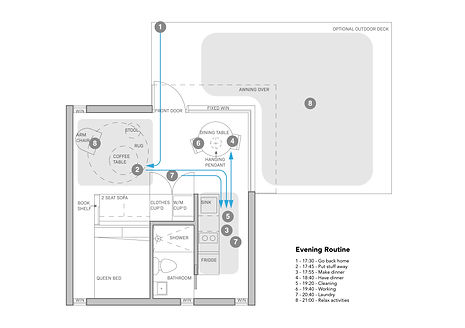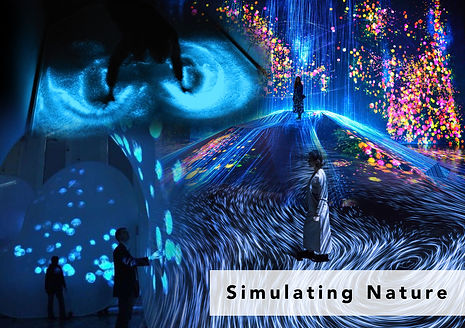
Applying interactive technologies within interior spaces in domestic apartments

Overview
Introduction
This is a cooperative project between RMIT University and Grimshaw. In this project we investigated Calm Technology and created Calm Interfaces for interiors of a detached house designed by Grimshaw, The Peak. The aim of this project is to explore the design of calm information as a representation of the physical contact with surfaces within interior spaces. It makes a contribution to the quality of living within the contemporary domestic apartment. It also offers new insights into the ways data can be considered in the design of the technical infrastructure and services within Architectural and Interior design practice.
Client
Grimshaw
My Contribution
Besides research based on group discussions, my key contribution in this project is technical support. As per my industrial background, I did the feasibility research about data input & output device. In addition, I learnt Processing by myself, so the interactive graphics coding was my responsibility. Furthermore, I also made half of the visualisation video for final presentation.
Team Members
Mengru Zheng
Xiaoying Li
Tim Smits
Li Zhou
Calm Technology
Problems are caused by interruptive technology, such as attention span, stress and lack of sleep in contemporary society. However, calm computing is used where the interaction between the technology and its users occurs in the users’ periphery rather than constantly at the center of attention, which informs users but doesn’t demand users’ focus. With calm technology, information captured from touching and moving over sensor augmented surfaces opens up opportunities to represent different states of these movements over networks as low-resolution sound or light events. Hence, compared with interruptive technology, which disturb users attention with too many devices, embedding calm technology into surfaces within interior environment could be the possibility to create more liveable domestic space.
About The Peak
As cooperation between RMIT University and enterprise, Grimshaw provided a tiny house named “The Peak” with low density in Melbourne. The Peak seeks to provide a high-quality tiny house that is affordable, sustainable and relocatable while offering all the features found in a modern home, for young people priced out of the housing market in Australia's cities. It is a 35-metre-square micro home with efficient spatial usability. Also, this pre-fabricated modular architecture offers customizable possibility.
Action Research
This research process aims to explore opportunities in terms of realistic human actions on surfaces within current apartment. In this stage, a typical apartment rented by one of our group mates (Xiaoying Li) is chosen for spatial analysis.









Actions on Surfaces
Balancing our initial group brainstorming and real domestic spaces of the chosen apartment. We listed existing user’s interactions with surfaces within this domestic space and analyse potential activities in personal perspective, which could be used to provide calming experience. Interesting themes are found within this domestic mixed-use space both interpersonally and personally.
As was found below, activities in existing domestic space could be divided into two groups, which are social interaction and mindfulness. As social interactions there are interesting activities such as cooking, eating together, playing games together, talking, having drink and watch movie together. As a contrast, watching view outside, listening to music, taking a shower, meditating, exercise and reading books are regarded as mindfulness. These finding contains some of activities engaging with electronic devices which draw users focus attention, and provide us opportunities for applying calm technology with low resolution human-machine interaction and creating new change.
Proxemics & Temporality
In this stage we analysed user’s actions based on space and time. With the evidence of user diary and spoken words we can acquire the information about how user interacts with surfaces daily within the existing apartment. After a discussion focus on user's realistic daily routine, information is collected and visualised into ethnographic diagram based on floor plan.
Based on users' movement, activities are categorised into fast-paced activities, during which users expressed that they must do something derived from tasks or chores, and slow-paced activities, which are regarded by users as ludic experience. After conversation with users about their emotion, fast-paced activities were renamed as utilitarian activities, while slow-paced activities were renamed as calming activities. The outcome from the ethnographic information shows that common space and bedroom could be used both for utilitarian activities and calming activities, especially an obvious overlapping space in bedroom, whereas bathroom is used for calming activities in user’s daily routine.
Dynamics & Transitions
This phase of study is undertaken to test and verify relationship among user experience, interactions, surfaces and space by collecting audio-visual data with shadowing design documentaries.
Evidence in the documentaries shows that a lot of utilitarian and calming activities happen near the French windows of user's bedroom, which could be regarded as key surface. In the organised video footage some unconscious insight became revealable such as taking cup on different surfaces, soundscape while making food, multiple social activities both utilitarian and calming, walking on carpet without shoes and yoga mat.
Patterns & Rhythms
Categorising data collected from habitant’s daily routine was synthesised into intrinsic patterns and rhythms in this stage. Hence, characteristics of calming activities and utilitarian are identified for potential habitants’ condition recognition and opportunities for transforming room conditions.
As a conclusion, four initial design opportunities could be took consideration:
1. Utilitarian actions could be transformed into calming experiences, which could reduce anxiety through transforming high-resolution attention into low-resolution peripheral attention.
2. Calming morning ritual could be enhanced to strengthen users delight experience at a start of a day.
3. Creating calming experience after utilitarian actions could refresh users mind during tiring period.
4. Different surfaces could be used to create calming ludic experience inspiring curiosity, exploration and aesthetic appreciation when users could enjoy their everyday life.
Further low-resolution interaction could be under consideration such as light, sound, vibration and colours.
Ideation
To explore design opportunities for “The Peak”, we built persona, potential timeline and mapped potential routine as per previous action research from realistic case.
Persona









Vision
Through desktop research and personal experience we found that nature has a major impact on people's calmness. Therefore we decided to focus on creating nature inspired calm interfaces that will improve people's wellbeing while living in “The Peak”.

Timeline
As per ubiquitous computing, calm technology could detect user’s actions within a space automatically. Hence the timelines were built for consideration about potential daily routine, potential human-surface interactions, and technological feasibility.
Routine Mapping
After mapping out persona movement within “The Peak”, the opportunity for enhancing calming experience appears in activities such as waking up, breakfast, relax indoor, meditate and yoga / exercise. We chose these activities to experiment interaction design ideation.
Mood Board
Besides technology, we also built mood boards to seek audio, visual, and emotional possibilities. After we filtered some keywords, finally we chose “natural patterns”, “simulating nature”, “touchable elements”, and “ambient sound” for further inspiration.
Exploration
In this step we explored several patterns, which could simulate natural elements in abstract graphics. The interaction was built based on mouse movement as a early experimental simulation.
Concept
Calm Nature is a smart home system embedded in “The Peak”. It could detect inhabitants’ daily behaviour, analyse & store data and then reacting calming visualisations.
Through the artificial intelligence system, the system could create a profile for every inhabitant by analysing personal movement. According to machine learning technology, it could compare difference and seek characteristics of data deviation zone, so that it could recognise which activity inhabitant is doing and how long it takes. The more data it collected, the accurate activities and inhabitants’ calm condition it could recognise because of machine learning. In the further concept exploration, if the system recognises inhabitants’ stressful condition, it could automatically start relaxing state and remind user to take a rest and enhance calmness with light and sound interaction.

Activity Map

Sensor Map





Experience -
Yoga / Exercise
When you want to do yoga or exercise you can go to the area in the house that’s dedicated to this space, there the floor has pressure sensors. Based on your balance, gentle bubbles will follow your movement, getting you more immersed into the practice. This visualisation can also be triggered automatically if the system senses you don't move for a long time.
Input variables: pressure sensor data (balance), time, personal movement data
Output: bubble balance visualisation, ambient soundscape

Experience -
Wake Up
You are woken up by a slowly increasing sounds of nature, wind blowing through trees, birds singing songs and ambient sounds (depending on your preference). This is accompanied by a virtual sunrise that’s created on your bedroom ceiling. This helps you wake up, as light activates your body after sleep.
Input variables: pressure sensor data, time, user's preference
Output: lights visualising sunrise, sounds of nature, wake up soundscape
Experience -
Breakfast
The moment you start eating breakfast at the dining table the table will simulate the weather forecast for the day, temperature and weather type will be visualised. This provides an calming yet functional experience that is not obtrusive.
Input variables: pressure sensor data, time, weather forecast
Output: weather visualisation, weather soundscape
Experience -
Relax Indoor
When people are sitting on the couch, different calming visualisations will be displayed on the walls of The Peak, which change depending on the time in the year and weather. This visualisation can also be triggered by the system if it thinks you need some time to rest.
Input variables: pressure sensor data, time, personal movement data
Output: rain visualisation, rain soundscape
Experience -
Meditate
If you sit down on the floor in front of the visualisation wall, a meditation visual will start, the visuals represent waves and can be used to guide your breathing and help you become present. This visualisation can also be activated when the system thinks you need a calm moment.
Input variables: pressure sensor data, users breathing movement, user's preference
Output: breathing visualisation, meditation soundscape

